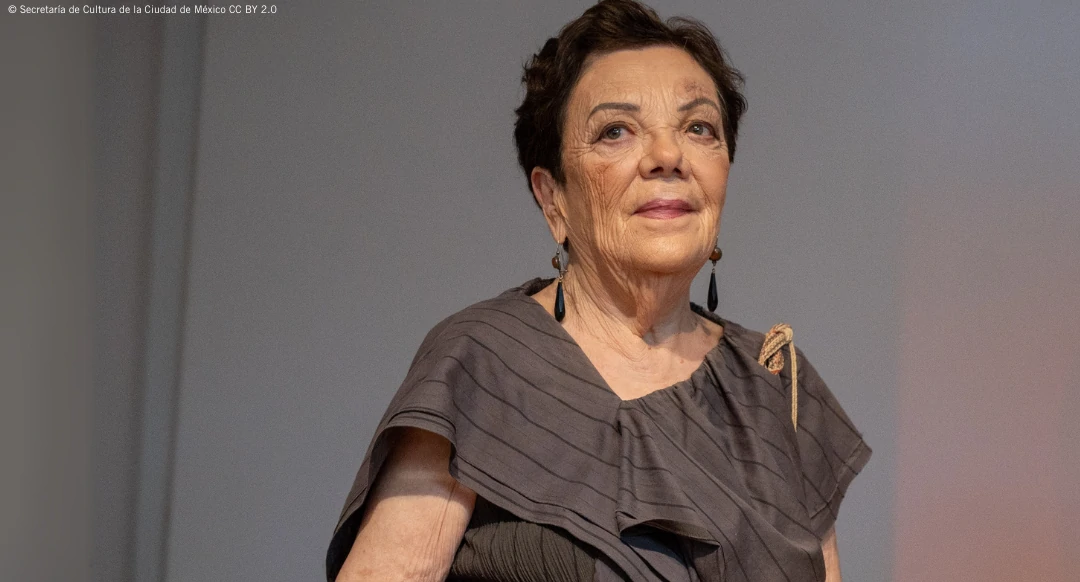Main content
Press releases
Graciela Iturbide, Princess of Asturias Award for the Arts

Mexican photographer Graciela Iturbide has been granted the 2025 Princess of Asturias Award for the Arts, as announced today by the Jury responsible for conferring said Award.
The Jury for the Award –convened by the Princess of Asturias Foundation– was chaired by Miguel Zugaza Miranda and made up of Claude Bussac, Oliver Díaz Suárez, Josep Maria Flotats i Picas, Maribel López Zambrana, Joan Matabosch Grifoll, Isabel Muñoz Villalonga, María Pagés Madrigal, Christina Rosenvinge Hepworth, Teresa Sapey, Carlos Urroz Arancibia and Aaron Zapico Braña (as acting secretary).
This candidature was put forward by Juan Duarte Cuadrado, Spanish ambassador to Mexico.
As an exception, due to the blackout that affected the Iberian Peninsula, the meeting was held via video conference.
Graciela Iturbide was born in Mexico City on 16th May 1942. In 1969, she began her studies at the University Center for Cinematographic Studies of the Autonomous University of Mexico (UNAM) (2009 Prince of Asturias Award for Communication and Humanities), with the intention of becoming a film director. However, after becoming familiar with the work of photographer Manuel Álvarez Bravo and attending his classes, she was drawn to the field of photography. She worked as Bravo’s assistant between 1970 and 1971.
Possessing an innovative perspective, Iturbide’s lens has captured the social reality not only of Mexico, but also of many places where she has been invited to work. Her work presents a documentary facet which, according to experts, shows “a hypnotic world that seems to lie on the threshold between reality at its harshest and the grace of spontaneous magic”. In the 1970s, she travelled throughout Latin America, primarily Cuba and Panama, and in 1978 was commissioned by the Ethnographic Archive of the National Indigenous Institute of Mexico to document the country’s indigenous population with projects in which she photographed, for example, the Seri and Juchitán peoples, resulting in the book titled Juchitán de las mujeres (1989). She subsequently continued her work in Cuba, East Germany, India, Madagascar, Hungary, France and the United States, a period that resulted in numerous works notable for their artistic depth and poetic sentiment. Over time, her predilection for portraiture and the depiction of human nature has evolved in her search for new subjects, such as landscapes and found objects, which her gaze endows with a transcendental vision through her characteristic use of black and white. In her own words, photography is for her “(…) a ritual. To go out with my camera, observe, photograph the most mythological aspects of people, then step into darkness, develop, select the most symbolic images”. Iturbide has had solo exhibitions at some of the world’s leading art centres and institutions, including the Centre Pompidou in Paris, the San Francisco Museum of Modern Art, the Philadelphia Museum of Art, the Getty Museum, the Fotomuseum Winterthur and the Barbican Art Gallery. Her work has also been published in several editorial volumes such as: Avándaro (1971), with texts by Luis Carrión; Graciela Iturbide: La forma y la memoria (1996), with texts by Carlos Monsiváis; Pájaros (2002), with texts by José Luis Rivas and Bruce Wagner; Graciela Iturbide: Eyes to Fly with / Ojos para volar (2006), with texts by Fabienne Bradu and Alejandro Castellanos; El baño de Frida Kahlo (2009); Graciela Iturbide: México-Rome (2011); and Graciela Iturbide: No hay nadie / There is no one (2011), with texts by Óscar Pujol.
Officer of France’s Order of Arts and Letters and holder of honorary degrees from Columbia College Chicago and the San Francisco Art Institute, Iturbide has received numerous awards throughout her career, including the W. Eugene Smith Memorial Fund Grant (USA 1987), the Grand Mois de la Photo à Paris Prize (France, 1988), the Guggenheim Fellowship (USA, 1988), the Hugo Erfurth Prize (Germany, 1989), the International Grand Prize (Japan, 1990), the Rencontres Internationales de la Photographie Prize (France, 1991), the National Prize for Sciences and Arts (Mexico, 2008), the PHotoESPAÑA Prize (Spain, 2010), the Lucie Award (USA, 2010), the Cornell Capa Award from the International Center of Photography (USA, 2015) and the William Klein Photography Award from the French Academy of Fine Arts (2023).
As stated in the Statutes of the Foundation, the Princess of Asturias Awards are aimed at rewarding “the scientific, technical, cultural, social and humanitarian work carried out at an international level by individuals, institutions or groups of individuals or institutions”. In keeping with these principles, the Princess of Asturias Award for the Arts is to be granted to “the work of fostering, cultivating and advancing architecture, dance, film-making, music, painting, photography, sculpture, theatre or any other form of artistic expression.”
In all, 49 candidatures comprising 19 different nationalities were put forward for the Award this year.
This is the fourth of the eight Princess of Asturias Awards to be bestowed in what is now their forty-fifth year. Previously, the Princess of Asturias Award for Communication and Humanities was granted to South Korean-born German philosopher and essayist Byung-Chul Han, the Princess of Asturias for Literature was conferred on Spanish writer Eduardo Mendoza and the Princess of Asturias Award for Social Sciences went to American sociologist and demographer Douglas Massey. The corresponding Awards for Sports, Concord, Technical and Scientific Research, and International Cooperation shall be announced in the coming weeks (in the preceding order).
As is customary, the presentation of the Princess of Asturias Awards will take place in October in a solemn ceremony presided over by Their Majesties The King and Queen, accompanied by Their Royal Highnesses Leonor, Princess of Asturias, and Infanta Sofía of Spain.
Each Princess of Asturias Award comprises a Joan Miró sculpture symbolizing the Award, a diploma, an insignia and a cash prize of fifty thousand euros.
End of main content
